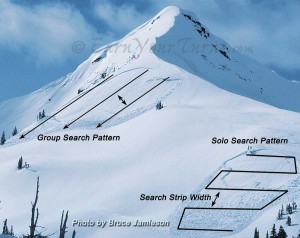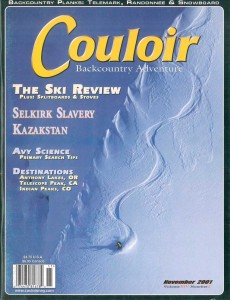What do you do next?
- Mentally mark the last place you saw your friend. If you’re in a group, determine who knows the lowest place that your friend was last seen.
- Switch your beacon(s) to receive mode.
If you’re in a group, someone must become the leader at this point. (This is a critical move, and a critical position worthy of an entire chapter in a book itself.) Among other things, the leader should check that everyone has their beacon in receive mode. Anyone who has ever practiced a group search knows that someone in the group usually doesn’t do this right, or they accidentally switch back in to transmit mode in the middle of the search. Of course, this puts everyone into a new state of confusion and slows down the search for your friend(s). Make sure you’re not the bonehead doing that. - If you don’t have a signal at all, then you need to begin moving towards your friend(s) down the slide path according to one of the following patterns.
Solo Search
Zig-zag your way down the slide path according to the Search Strip Width of your beacon. The idea here is to cover as much ground as fast as possible to get to your friend quickly. Besides not lolligagging around, it is important to be familiar with how wide the search strip width of your beacon is. That requires a bit of experience with judging distance. If you are too conservative, your zig-zags will be tighter than necessary, slowing down your progress. If too large, you might miss the signal and have to go back uphill and repeat.
Group Search
Assuming you have enough people, have everyone in the search party spread out across the width of the slide path. The leader should set the distance between searchers to be the Search Strip Width of the weakest beacon. If no one is sure what that is, be conservative and use 20 meters (66 feet). Unless you don’t have enough people to adequately cover the path width, it won’t hurt to over sample the search path. The searchers on the ends should have at least half that distance between themselves and the edge of the slide path. The leader will then coordinate movement down the slide path. Experienced leaders will control the search party by moving everyone 20 meters at a time, then checking to note if anyone has picked up a signal, then doing a paced move again, until your buried friends signals are picked up.
This article was first published in Couloir magazine Vol. XIV-2, Nov. 2001.
© 2001



Recent Comments